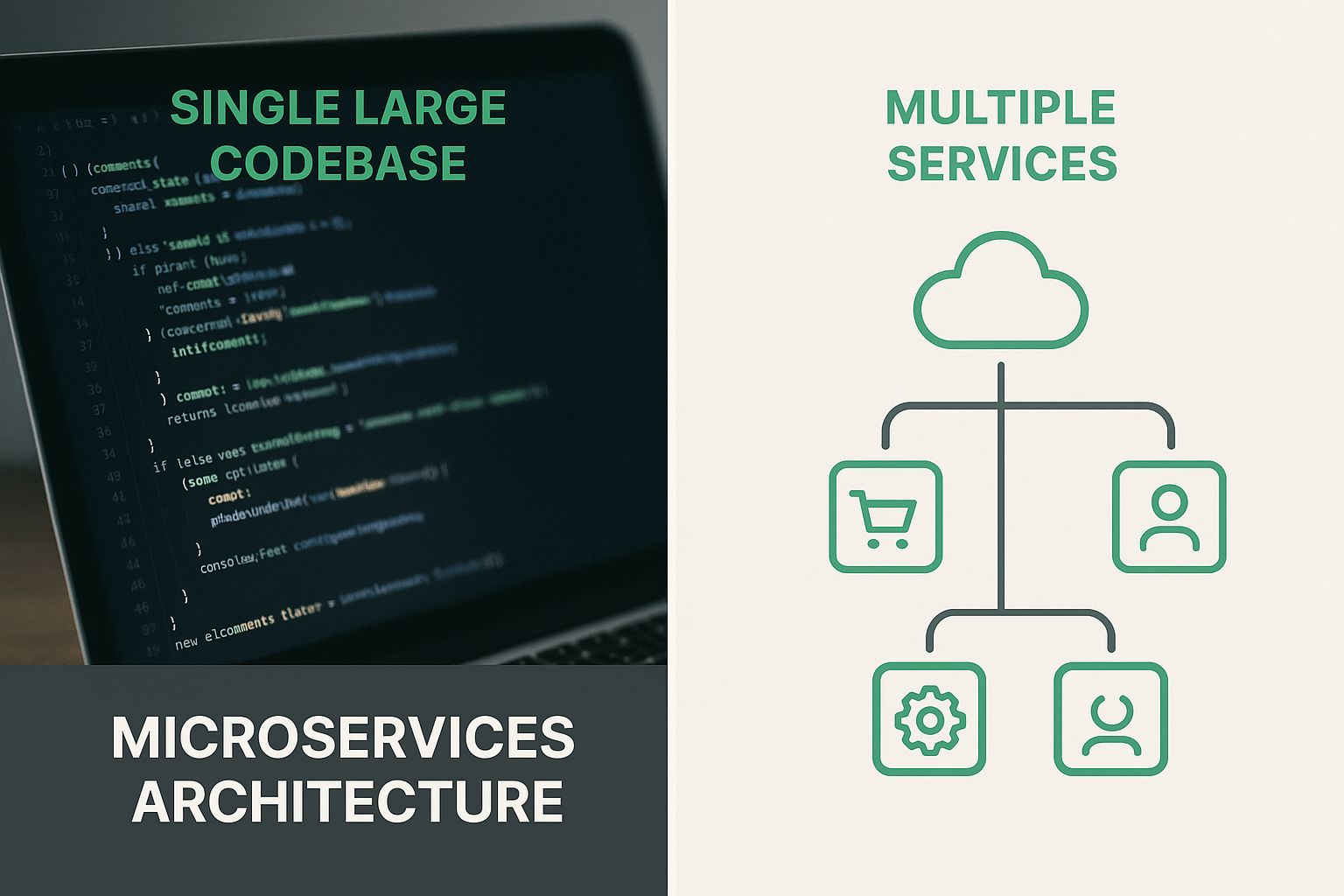Master system design and architecture with battle-tested strategies that scale. Learn from engineers who've built systems handling millions of users.

Imagine laying the groundwork for a skyscraper. You wouldn’t start pouring concrete without blueprints, right? Similarly, system design and architecture is the blueprint for your software. It’s the foundation upon which all your code rests.
Let’s get one thing straight: system design isn’t just a fancy term. It’s the process of figuring out what parts your software needs, how they’ll fit together, and what data they’ll use. Think of it as deciding what ingredients go into your cake and how they’ll be mixed. This includes the “what”—the features—and the “how”—the technical details.
Architecture, on the other hand, answers the “why.” It’s the overall strategy, the guiding principles. It’s like choosing whether to make a single-layer cake or a multi-tiered masterpiece. A key architectural decision, for instance, might be choosing between a microservices architecture and a monolithic architecture. This choice has major implications down the line.
This difference matters. Architectural decisions affect everything, from the programming languages you use to how your team works together. A solid architecture ensures all parts of your system work in harmony, making it easier to scale and maintain. A poorly chosen architecture, however, can lead to a system that’s fragile, hard to update, and ultimately, doesn’t meet anyone’s needs.
Every single line of code you write stems from your architectural choices. Imagine building a house: your foundation determines the size and layout of your rooms, the position of the walls, and even the type of roof you can install. The same applies to software.
For example, choosing a service-oriented architecture (SOA) means you’ll need clear communication channels between your services. This influences the technologies you choose, your development process, and even how fast your system runs. This ripple effect underscores the importance of carefully planning your architecture from the start. It’s much easier to get the foundation right initially than to try to rebuild it later. And the growing importance of this field is reflected in its market size. The global architectural services market, which includes system design for digital infrastructure, is projected to reach US****** 409.75 billion in 2025**. Discover more insights into this growing market. This demonstrates the increasing need for robust and well-designed systems. Effective system design and architecture is about choosing the right approach for your needs and laying a solid foundation for the future.
Diagrams and documentation are important, but they’re not the whole story. Great system design is about practical application. It’s about understanding how theory translates into real-world performance, how your system will scale as it grows, and how easy it will be to maintain over time.
It’s less about creating perfect diagrams and more about making informed decisions that balance different needs. This practical focus sets truly skilled architects apart. In the next sections, we’ll delve into the key principles and patterns that make systems strong and scalable.

This infographic shows the journey from a monolithic codebase to a microservices architecture. Notice how microservices break a large application down into smaller, independent services. This offers greater flexibility and scalability in system design and architecture.
Let’s move past the theoretical jargon and explore the design principles that seasoned engineers use daily. These principles are invaluable, especially when balancing competing priorities and tight deadlines. They are essential for creating robust and maintainable systems.
The single responsibility principle states that every component in your system should have one, and only one, job. Imagine a restaurant: the pastry chef handles desserts, the sous chef manages main courses, and the head chef oversees the entire operation. If the head chef attempted every task, it would be pure chaos!
Similarly, if a single software module handles too many tasks, it becomes a breeding ground for bugs and a nightmare to update.
This principle isn’t just an academic idea; it’s the key to creating code that’s easy to maintain. When each component has a specific responsibility, it becomes simpler to understand, test, and modify without causing unintended consequences.
Think of building with LEGOs. If every brick were glued to the one beneath it, you couldn’t change anything without the whole structure falling apart. This is what tightly coupled systems are like. Dependency inversion, however, provides the equivalent of LEGO connectors, allowing components to be swapped and rearranged.
Instead of high-level modules relying directly on low-level modules, both depend on abstractions. This lets you swap implementations without impacting other system parts, promoting flexibility in system design and architecture. This is especially crucial in dynamic environments with frequently changing business needs.
Ever encountered a light switch that turns the lights off when flipped up? It’s unexpected and annoying. The principle of least surprise aims to prevent this in software.
Your system should behave predictably. Code should be easy to understand and navigate, even for new team members. This principle emphasizes clarity and reduces cognitive load, simplifying system maintenance and expansion. You might find this helpful: our guide on software design principles.
While performance is important, premature optimization can actually harm your project. Obsessing over micro-optimizations before understanding the overall system design can create unnecessarily complex code that’s harder to maintain and debug.
This doesn’t mean ignoring performance entirely. Focus on building a solid architecture first, then address performance bottlenecks after profiling and identifying areas needing improvement.
Imagine a bridge designed to withstand the failure of a single support cable without collapsing entirely. This is the essence of graceful degradation. In system design, it means building systems that function even when some parts fail.
Implementing redundancy and fallback mechanisms minimizes the impact of failures and prevents total system outages. This is essential for maintaining user trust and ensuring business continuity, especially in distributed systems.
To summarize these key principles, let’s look at the table below:
Design Principles That Drive Success Essential principles compared by their real-world impact, implementation challenges, and the business outcomes they enable
Applying these principles thoughtfully will greatly improve the quality and longevity of your software projects.

Think of architectural patterns as tried-and-true solutions to common software design problems, not just abstract theories. They’re the practical tools we use to build robust, maintainable systems. You might find this helpful: exploring various software architecture patterns.
Imagine a large orchestra attempting a complex symphony without a conductor – chaos, right? Large software projects can similarly become difficult to manage without a way to break them into smaller, more manageable pieces. This is where microservices shine.
This architecture divides your application into small, independent services. Each service handles a specific business function and can be developed, deployed, and scaled independently. This structure empowers teams to operate autonomously, fostering faster development and quicker iterations.
Think of Spotify. They use microservices to allow hundreds of developers to work concurrently on different parts of their platform. This structure allows rapid feature releases without the bottleneck of massive team coordination.
Picture a line of dominoes. One event triggers the next in a chain reaction. Event-driven architecture operates on a similar principle. Systems communicate through asynchronous events rather than direct calls between services.
This is perfect for complex workflows where services need to respond to events without being directly linked. Airbnb, for example, utilizes an event-driven architecture for their booking process. A new booking triggers notifications, payment processing, and calendar updates without direct interaction between each service.
While distributed systems often get the spotlight, sometimes a well-structured monolith is more effective than a complex distributed system. A monolith is a single, unified application, simplifying deployment and debugging, particularly for smaller teams or projects with limited resources.
When deciding between a monolith and microservices, consider your team’s size and experience, along with the project’s complexity. Sometimes, a simpler architecture is just more manageable. Interestingly, the tools that support system design are also rapidly changing. Architecture design software is expected to reach a market value of $10.95 billion by 2029, with a 16.0% CAGR from 2025. Learn more about this market growth.
Hexagonal architecture, also known as ports and adapters, emphasizes isolating core business logic from external dependencies (like databases or UIs). This simplifies testing and makes the application more adaptable to changes in those dependencies.
CQRS (Command Query Responsibility Segregation) separates read and write operations. This allows for specialized optimization of each, particularly beneficial for systems with heavy read and write loads.
Knowing when your current architecture is no longer effective is key. Are deployments becoming a headache? Are performance bottlenecks emerging? Is onboarding new developers difficult? These might signal a need for architectural change.
Each pattern has its strengths and weaknesses. Choosing the right one depends on the specific challenges you face, your team’s skillset, and the trade-offs each approach presents. Careful consideration of these factors allows you to create a robust and scalable system that effectively addresses real-world problems.
Scaling isn’t just about handling sudden success; it’s about flourishing under pressure, keeping your team productive, and your users happy. Think of it like a restaurant suddenly becoming incredibly popular. You need more than just extra tables; you need a whole new system to manage reservations, seating, and orders. Let’s explore some time-tested strategies by looking at how successful companies have tackled these challenges.
Think of Instagram in its early days. They made smart choices with their system’s design, allowing a small team to handle incredible growth. Similarly, WhatsApp’s focus on simplicity let them handle billions of messages every day. But even these giants made choices that later required extensive rewrites. Their journeys highlight how system design is a constantly evolving process.
When scaling, understanding the difference between microservices and APIs is key. It’s like understanding the difference between the individual parts of an engine (microservices) and the steering wheel that controls it (API). A helpful resource on this topic is Microservices vs API. This understanding helps you structure your system for growth and how it interacts with other applications.
Imagine a single toll booth on a busy highway. As traffic grows, that booth becomes a major chokepoint. The same happens in software. Identifying these bottlenecks before they become critical is crucial for effective scaling. This involves monitoring, load testing, and analyzing performance.
These bottlenecks can often appear in unexpected places, like database connections or network delays. Knowing how to pinpoint these issues lets you fix them before they impact your users.
One powerful scaling technique is database sharding. Imagine splitting a massive library’s collection across different rooms, each organized by topic. This is similar to sharding, where you divide your database across multiple servers. It allows for faster access and less strain on any single server.
But sharding isn’t a perfect solution. It adds complexity, especially when keeping data consistent and managing transactions across multiple shards. Knowing when to use sharding and when to explore other options is an important skill in system design.
Imagine a network of warehouses strategically placed around the world. These warehouses stock copies of popular products, letting customers get them quickly from a nearby location. This is essentially how content delivery networks (CDNs) work.
CDNs keep copies of your website’s static assets (like images and videos) closer to your users. This reduces delays and improves user experience, especially for users far from your main servers.
Caching is similar, storing frequently used data in memory for even faster access. Good caching strategies drastically reduce database load and make your application much more responsive.
Different scaling methods suit different situations. A small startup has different needs and resources compared to a large enterprise. Choosing strategies that fit your team’s size and budget is essential.
Some scaling challenges require significant changes to your system’s structure, like moving to microservices. Others might just need better tools or smarter resource allocation. Recognizing these differences lets you prioritize effectively and use your resources wisely.
Unexpected surges in traffic can overwhelm unprepared systems. Designing systems that handle these spikes gracefully, without needing an emergency response, is key to robust system design. This involves things like auto-scaling, where servers are automatically added or removed based on demand, and load balancing, which spreads traffic evenly across multiple servers.
By preparing for these scenarios, you ensure your system remains stable and responsive even under pressure. This minimizes disruptions and keeps users happy.
Your database is the bedrock of your system. A well-chosen database empowers your application, while a poor choice can lead to years of frustration. This goes beyond simply picking SQL or NoSQL. It’s about carefully considering data consistency, user experience, and future scalability when making architectural decisions.
The age-old SQL vs. NoSQL debate often misses the mark. The real question isn’t about which technology is inherently superior, but rather which best aligns with your system design and architecture. SQL databases shine when it comes to ACID properties (atomicity, consistency, isolation, and durability). These properties guarantee data integrity, crucial for applications like financial transactions or inventory management.
Think of SQL databases as meticulous accountants, ensuring every transaction is perfectly balanced and recorded.
NoSQL databases, on the other hand, prioritize flexibility and scalability. They often utilize eventual consistency, meaning data might be temporarily out of sync but will eventually converge. This works well for applications like social media feeds or online gaming. Imagine sending a group text – not everyone receives it instantly, but eventually, everyone gets the message.
The business world is constantly evolving, and your database needs to adapt. Designing schemas that can evolve gracefully without massive system overhauls is essential. This means careful planning, anticipating future requirements, and selecting adaptable data models. Cost is a major factor when scaling systems; consider exploring options like affordable web hosting solutions.
Database normalization is akin to organizing a library with meticulous cataloging. Each piece of information resides in its designated spot, minimizing redundancy and ensuring consistency. Denormalization, however, is like keeping multiple copies of popular books readily available. It boosts read performance by reducing the need for complex joins but introduces the potential for data inconsistencies.
The secret lies in finding the right balance. Normalize where data integrity reigns supreme and denormalize strategically where read performance is critical.
Just as a skilled craftsperson uses different tools for various tasks, modern systems often benefit from polyglot persistence. This involves using multiple database technologies, selecting the right database for each specific job. You might use a graph database for social connections, a document database for product catalogs, and a relational database for financial transactions.
While this targeted approach optimizes each workload, it also introduces operational complexity. Careful planning and robust tooling are crucial to avoid creating a maintenance nightmare.
Imagine a city divided into districts, each managed by its local government. Data partitioning works similarly, distributing your data across multiple servers. This improves both performance and scalability, allowing your system to handle increasing loads without performance degradation.
Various partitioning strategies exist, each with its own set of trade-offs. Selecting the appropriate approach depends on factors like data distribution, query patterns, and your system’s overall architecture. This directly impacts both performance and long-term maintainability.
To help you navigate these choices, let’s examine a framework for making informed database decisions:
Database Architecture Decision Framework
A practical comparison of database approaches, their real-world trade-offs, and the scenarios where each excels.
This table provides a high-level overview. In practice, choosing a database often involves nuanced considerations specific to your application’s needs.